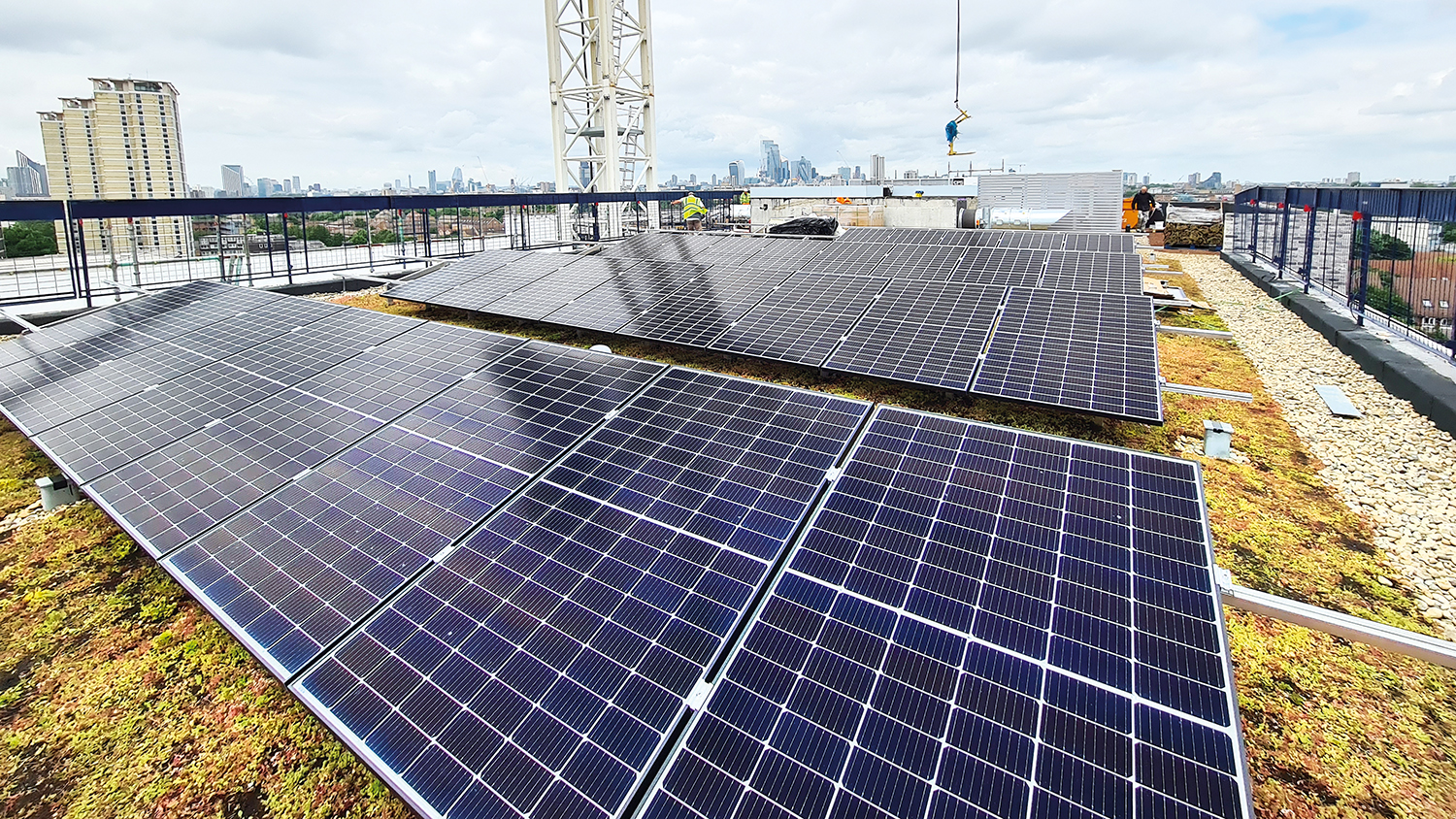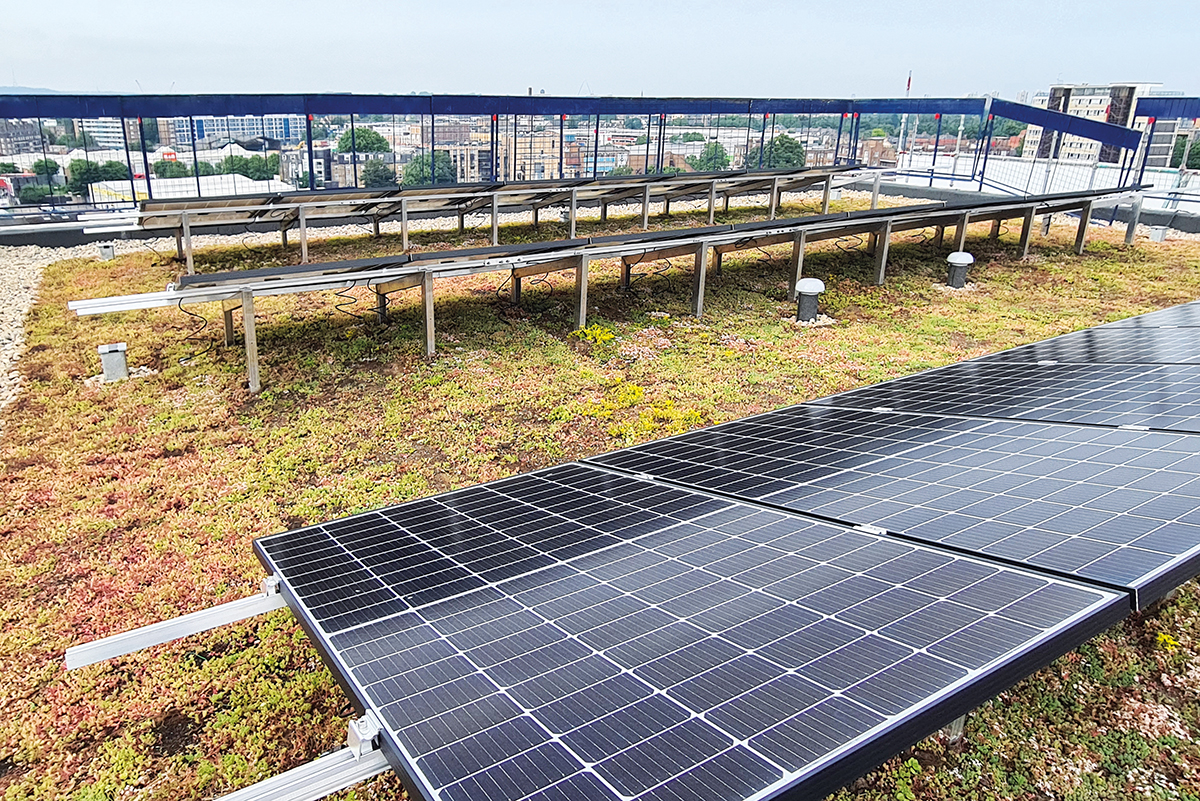
What are biosolar roofs and how should you design, install and maintain them? Mark Harris from the Green Roof Organisation explains.
The inclusion of biosolar green roofs within Department for Education (DfE) generic design briefs has raised the profile of this sustainable method of roof construction. But what is a biosolar roof?
What you will learn in this CPD
- Key standards to follow for biosolar roof installation
- Best practice guidance from the Green Roof Organisation
- Case study on a recent biosolar roof project
A biosolar roof combines a green roof, typically sedum or wildflower (extensive) or biodiverse (semi-extensive) with solar photovoltaic (PV) panels. This merges the benefits of management of surface water run-off from the roof with CO2 capture and the utilisation of the evaporative cooling of the vegetation to increase the efficiency of the PV panels.
Here are the key technical points to consider when designing, specifying, installing and maintaining a biosolar roof.
1. Biosolar support frames
The purpose-made support frame systems for PV panels are designed as an integral component of a green roof system. They are secured in place by the superimposed load of the green roof build-up rather than being fixed to the roof structure. This avoids the requirement for support fixings to penetrate the roof waterproofing and structure.
Typically designed for use on roofs with a pitch of up to five degrees, a biosolar PV support frame maximises the vegetated area of the roof, unlike PV mounts ballasted with paving slabs or stones.
The support frame system, if manufactured from aluminium, should be designed and tested in accordance with the relevant sections of BS EN 1991-1-4:2005 (Actions on Structures) and BS EN 1999-1-1:2007 Eurocode 9 (Design of Aluminium Structures). If manufactured from steel, BS EN 1993 Eurocode 3 (Design of Steel Structures) applies.
2. Design and specification
When designing a biosolar roof, the following should be requested from the biosolar system supplier as early in the design process as possible:
- a layout plan showing the position of the biosolar supports and panels for each roof area or areas;
- the spacing between panel rows;
- a wind loading report, using local weather data, for each roof – calculations should be in accordance with BRE Digest 489 and specifically BS EN 1991-1-4 (Actions on Structures); and
- a plan showing differing ballast loadings if a zonal arrangement is required.
Sufficient substrate depth should be provided to ensure that the dry weight of the green roof build-up provides sufficient ballast loading to comply with the output of the project-specific wind loading calculation.

Solar panels should be positioned to allow sufficient space between each row to allow for safe and practical maintenance of both the PV panels and the green roof.
Minimum spacing should be sought from the biosolar system supplier but the Green Roof Organisation (GRO) recommends:
- minimum 200mm from the low point of each solar panel to the top of the green roof substrate surface;
- minimum 1.5m between solar panels and roof perimeters;
- minimum 750mm between solar panels and rooflights/atriums/features;
- no encroachment of PV panels over roof level fire breaks;
- not positioning biosolar base boards within pebble vegetation margins;
- not installing biosolar base boards directly on substrate or aggregate layers; and
- no shading of solar panels from vegetation or other roof features.
3. Key design considerations
Each biosolar support should be located over a stable surface such as:
- a waterproofed warm roof;
- an inverted roof, above the insulation board and water flow reducing layer (WFRL);
- a suitable void former; or
- a green roof drainage board layer with filter fleece.
Manufacturers’ installation recommendations should always be followed.

4. Fire considerations
Guidance in the Department for Communities and Local Government’s (DCLG) Fire Performance of Green Roofs and Walls (August 2013) and the GRO Code of Best Practice should be followed to meet the fire performance requirements of the building regulations.
Cabling associated with the PV system running along the substrate surface or within the green roof build-up should be contained within a closed conduit. All electrical works associated with the installation and commissioning of the PV panels is to be as required within MCS guidelines.
5. Maintenance
All green roofs will require regular maintenance and biosolar roofs are no exception. The removal of dead vegetation as part of a planned maintenance programme will help prevent fire risk through increases in organic matter.
GRO recommends that all biosolar roofs are maintained at least twice a year as a minimum to:
- keep vegetation below a height where it shades the solar PV array;
- ensure a minimum gap of 200mm between lower edge of PV panel and substrate surface is maintained;
- remove biomass (old seed heads and dead vegetation) especially in the autumn; and
- check that any fire breaks are cleared of vegetation or combustible material.
Additional maintenance activities should also include:
- removal of invasive weed species;
- removal of individual plants causing shading to the panels;
- ensuring depths of substrate remain correct as per the original wind loading requirements;
- reseeding of bare areas in the vegetation as required; and
- cleaning and inspection of the solar PV panels.
A record of each visit and work completed should be provided to the entity responsible for maintenance of the building. Failure to carry out regular maintenance will affect the performance of the green roof and the power output of the solar PV array and may increase potential fire risk.
6. Irrigation
If an irrigation system is provided, it is important not to over-irrigate the vegetation under and directly around PV panels to avoid excessive growth and potential shading issues. l
Mark Harris is head of sustainability at SIKA, secretary of the Green Roof Organisation, and a fellow of the Institute of Roofing. For further information on biosolar roofs, go to: www.greenrooforganisation.org.
Case study: St Edward’s C of E School, Havering, Essex

Green roof specialist Pritchard & Pritchard installed an 894 sq m wildflower biosolar project on an Essex school. The project features 180 PV panels mounted on manufacturer ZinCo’s Solarvert mounting system, ballasted by ZinCo green roof substrate and wildflower mats.
The drainage layer comprises a protection mat, Floradrain FD40 drainage board and SF filter fleece. The edge protection is the ZinCo ASG ballasted maintenance railing system. The 140m of railing has no penetration through the waterproofing and is ballasted by the green roof.
The wildflower mix aims to attract pollinators and other invertebrates. It includes: birdsfoot trefoil, black medick, bladder campion, bulbous buttercup, common toadflax, corn chamomile, cornflower, cowslip, devil’s bit scabious, field poppy, greater burnet, kidney vetch, lady’s bedstraw, musk mallow, oxeye daisy, rough hawkbit, salad burnet, selfheal, small scabious, viper’s bugloss, wild carrot, wild clary, wild mignonette and yarrow.
Pritchard & Pritchard completed the project in 2023.





